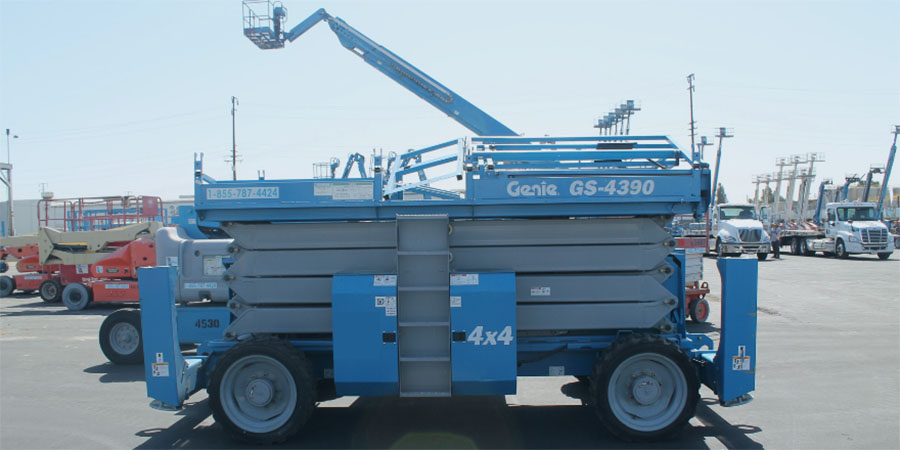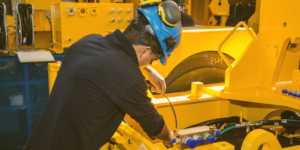Equipment inspections are routine tasks that are easy to overlook yet still play a critical role in business operations. Proper inspections enable operators, mechanics, and fleet managers to maintain their fleets better and confidently deploy assets, knowing they are safe for use.
Compliance with the American National Standards Institute (ANSI) requires periodic and annual inspections of aerial work platforms. Annual inspections must be performed by a qualified mechanic with knowledge of the specific type of aerial equipment or one of similar design characteristics, as outlined in ANSI provisions A92.6 and A92.5 section 6.6. These records are then to be kept for at least five years.
Additionally, regular evaluations of machinery are pivotal in extending the service life of construction assets. Let’s explore the methodologies and best practices that ensure equipment reliability and operator safety.
Why Keep Inspection Records?
The primary reasoning is that in the event of an accident, authorities, including the Occupational Safety and Health Administration (OSHA), will seek these inspection records as part of their investigation. You may be subject to financial penalties if you cannot provide proper documentation.
Completing inspections digitally is the best solution for keeping accurate records that are easy to access. Digital records don’t clutter your office space; when you need them, you can retrieve and share them in seconds.
What to Inspect and When?
Annual inspections are in-depth inspections covering the structural components of the equipment. The second purpose is to review safety items like decal legibility and placement.
Under ANSI, periodic inspections are required every “3 months or 150 hours” (whichever comes first). The inspections should cover items that affect the asset’s usability during inspection. These inspections likely include engine and hydraulic oil levels, parking brakes, lights, safety features, boom, and platform controls.
Ideally, teams should also inspect aerial assets before and after each rental. Before an asset goes out on rental, inspections should cover functionality and safety features to ensure a reduced risk of an accident and mitigate liability. Inspections upon asset return benefit mostly from better visibility into fleet status.
Added Benefits of Keeping Inspection Records
Everyone knows that a well-maintained asset will have a higher resale value. Inspection forms are a great source of proof of condition over time that can help you get the most out of the resale of your assets.
Being known as a company that frequently inspects its equipment can also boost your reputation. Customers value safety, especially when it comes to working at heights. So, by inspecting your equipment regularly, their confidence and trust in you as a provider will skyrocket.
Overall, these simple tasks can only benefit your business. Between customer confidence and mitigating your liability in the case of an accident, the investment in a five-minute inspection process is repaid tenfold in the long run.
Pro Tip: Transition to digital inspection records to streamline documentation, ensure easy access, and enhance compliance with safety regulations. It will boost customer trust and maximize asset resale value.
Uncover Cost Savings with Preventative Maintenance of Heavy Machinery
Companies investing in preventive maintenance for heavy equipment can anticipate substantial cost savings. Regularly scheduled maintenance extends the machinery’s lifespan, reducing the frequency and expense of major repairs. Unplanned downtime, which can halt production and incur steep costs, decreases significantly when preventive measures are consistently applied.
Breakdown of Potential Cost Savings Over Time
Maintenance strategies that prioritize prevention rather than reactive repair convert into financial benefits. For instance, replacing a worn-out part before failure can be up to 10 times less than an emergency repair, including the associated downtime costs.
- Service Life Extension: Consistent inspections and maintenance can increase the service life of equipment by considerable margins.
- Resale Value: Equipment with a documented maintenance history typically sustains higher resale values.
- Downtime Reduction: Proactive servicing reduces downtime costs.
Impact on Lowering Job Site Delays Due to Equipment Failure
Meticulous application of preventive maintenance protocols measurably diminishes jobsite delays attributed to equipment malfunctions. Reducing these incidents instigates a chain reaction of benefits, including improved project timelines, enhanced productivity, and strengthened client relationships.
An Association of Equipment Management Professionals report reveals that firms with effective maintenance programs have improved equipment availability rates by up to 20%, thus directly affecting project completion and profitability.
Pro Tip: Implement a preventive maintenance program to significantly cut repair costs, extend equipment lifespan, and minimize costly unplanned downtime. It will enhance productivity and raise resale values.
Challenges and Best Practices in Managing Rental Equipment Fleets
Managing rental equipment fleets presents a complex set of challenges due to the diversity of the machinery and the different inspection requirements for each type of command. Each piece of equipment typically comes with unique specifications, usage parameters, and maintenance needs, which can be taxing to monitor and maintain.
For instance, a construction company’s inventory might range from earthmoving machines like excavators to aerial equipment such as boom lifts, each requiring distinct inspection protocols that adhere to various safety standards and operational guidelines.
Managing Diverse Fleet Inspection Requirements
Operators of rental equipment fleets must maintain a high level of vigilance to ensure each piece of equipment is inspected thoroughly and regularly. It often involves creating a customized inspection schedule for each type of machinery and training personnel accordingly.
Diverse fleet management further entails a detailed record-keeping system that logs every inspection, maintenance, and repair activity, which is critical in mitigating the risk of equipment failure and extending the lifespan of the machinery.
Centralized Best Practices for Equipment Management
- Standardize Procedures: Implement uniform inspection and maintenance processes across all equipment.
- Data Collection and Analytics: Use centralized management systems to collect data and analyze equipment wear and performance trends.
- Software Integration: Integrate software solutions for equipment health monitoring, usage analysis, and informed maintenance decisions.
- Proactive Maintenance: Adopt proactive maintenance to predict and address potential equipment faults, reducing downtime and emergency repair costs.
- Training Programs: Provide comprehensive training for operators on specific inspection procedures and safe equipment operation.
- Maintenance and Inspection Calendar: Develop tailored maintenance and inspection schedules for each machine type.
- Documentation System: Implement a reliable system to track equipment history and identify patterns for preventive maintenance.
- Technology Utilization: Use fleet management software to centralize data and enhance decision-making.
By confronting the complexities of diverse fleet management with standardized processes, centralized data systems, and ongoing training, rental equipment fleet managers strengthen their machines’ reliability, safety, and availability, thus fostering positive customer relationships and achieving economic success.
Heavy Equipment Wear and Tear: What to Look For
Regular inspection of heavy equipment assesses signs of wear in vital components to maintain operational integrity and extend machinery lifespan. Identifying equipment damage early leads to timely interventions, safeguarding functionality and value. When inspecting heavy equipment, focus on several key aspects to ensure comprehensive oversight.
Identifying Common Signs of Machinery Wear in Vital Components
Start with scrutinizing mechanical parts. Evaluate the degree of wear on moving components, looking for abrasions, distortion, and cracks. Check for oil leaks, unusual noises, or vibrations that may indicate internal issues. Inspect hydraulic systems meticulously for signs of leaking fluid or damaged hoses.
Assess electrical systems for corroded connections and frayed wires. Also, examine undercarriage components for track tension and worn sprockets or rollers. In addition, make sure to observe the structural integrity of booms, arms, and frames for any signs of fatigue or stress fractures.
Special Considerations for Rental Fleets’ Regular Turnover
Rental heavy equipment often undergoes high utilization rates, leading to frequent turnovers. Therefore, rigorous check-in and check-out procedures catering to machine specifics must be implemented. Inspect tire and track conditions, considering the surface types and workloads experienced.
Document engine hours and service intervals, correlating them with maintenance schedules. Pay closer attention to operator compartments for potential damage due to varied usage patterns. Emphasizing these specific measures maintains optimal conditions of rental fleets, notwithstanding the regular turnover.
Thorough assessments for wear and tear remain a cornerstone in preserving the performance and safety of heavy equipment. Operators and inspectors should become accustomed to a detailed scrutiny process, as this proactive approach significantly reduces the likelihood of unexpected machinery downtimes and costly repairs.
Enhancing Uptime and Reliability Through Inspections
- Significance of Inspections: Regular inspections improve equipment uptime and ensure consistent performance, which is crucial for construction, mining, and other industries.
- Early Issue Detection: Inspections detect potential failures early, enabling timely repairs and preventing unexpected breakdowns.
- Operational Continuity: Regular inspections ensure operational capability, avoiding delays leading to significant financial penalties.
- Economic Benefits: Inspections extend equipment lifespan, maximize return on investment, and promote sustainable operations by reducing premature asset replacement.
How Do Equipment Inspections Increase Client Trust and Loyalty?
When rental companies adhere to strict inspection protocols, they give customers confidence that they invest in quality equipment.
Trust grows when customers experience fewer equipment failures and project delays, directly impacting their perception of the rental company’s reputation and dependability.
Repeat Business Fueled by Quality Inspections
Rental customers often determine which company to rent from based on the quality of the equipment and the trust in its performance. Thorough inspections lead to well-maintained machinery that functions efficiently, reducing the occurrence of breakdowns. This reliability encourages customers to return for future rentals, boosting repeat business.
Customers who trust the equipment’s performance can focus on their core operations, knowing the rented machinery will meet their project requirements.
Fortifying Customer Relationships with Dependable Equipment
Strong customer relationships are built through personal interactions and also through the consistent provision of dependable equipment. Quality inspections play a significant role in ensuring that equipment operates optimally.
Rental companies prioritizing inspections are more likely to foster long-term relationships with clients who value dependability as a critical factor in their rental decisions. This dedication to equipment quality and safety reflects the rental company’s commitment to excellence, reinforcing customer loyalty.
Pro Tip: Adhere to rigorous inspection protocols to ensure equipment reliability and safety, boosting client trust, repeat business, and long-term customer relationships.
Mastering Heavy Equipment Inspections: The Foundation of Your Rental Business Success
Heavy equipment inspections are the foundation for a prosperous rental business, marrying the twin pillars of safety and business success. Consistently well-maintained equipment facilitates operations that adhere to the highest safety standards, ensuring the well-being of operators and personnel on the job site. Further, these practices contribute to equipment longevity, reducing downtime and fostering customer trust, which inevitably translates to business growth.
Consider the integral role of heavy equipment inspections in averting potential liabilities while reinforcing a reputation for reliability and quality service in the construction industry. Rental companies that prioritize regular maintenance and adopt robust inspection protocols are poised to navigate competitive environments more effectively and can anticipate the benefits of cost control and enhanced operational efficiency.
Want to learn how a Rental Management solution can make inspections easier and more intuitive?
Key Takeaways
- Compliance with ANSI standards and regular inspections (annual, periodic, pre-, and post-rental) are crucial for ensuring equipment safety, reliability, and longevity. Proper inspections help prevent accidents, maintain operational integrity, and improve resale value.
- Maintaining accurate and accessible inspection records, preferably digitally, is essential for complying with regulatory requirements and protecting against potential financial penalties. These records are vital in case of accidents and can support resale value by providing consistent maintenance.
- Investing in preventative maintenance can lead to substantial cost savings by reducing emergency repairs and downtime. Proactive maintenance extends the machinery’s lifespan, lowers maintenance costs, and enhances equipment availability and reliability.
- Rigorous inspections and well-maintained equipment build client trust and loyalty, leading to repeat business and strong customer relationships. This dedication to safety and reliability enhances the rental company’s reputation and contributes to business growth and operational efficiency.



 December 5, 2024
December 5, 2024 4 minutes read
4 minutes read